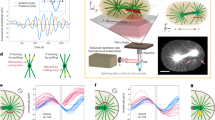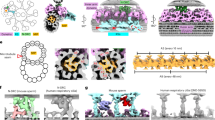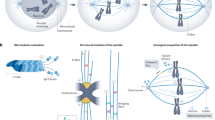Abstract
In early embryos, microtubules form star-shaped aster structures that can measure up to hundreds of micrometres in size, and move at high speeds to find the geometrical centre of the cell. This process, known as aster centration, is essential for the fidelity of cell division and development, but how cells succeed in moving these large structures through their crowded and fluctuating cytoplasm remains unclear. Here, we demonstrate that the positional fluctuations of migrating sea urchin sperm asters are small, anisotropic, and associated with the stochasticity of dynein-dependent forces moving the aster. Using in vivo magnetic tweezers to directly measure aster forces inside cells, we derive a linear aster force–velocity relationship and provide evidence for a spring-like active mechanism stabilizing the transverse position of the asters. The large frictional coefficient and spring constant quantitatively account for the amplitude and growth characteristics of athermal positional fluctuations, demonstrating that aster mechanics ensure noise suppression to promote persistent and precise centration. These findings define generic biophysical regimes of active cytoskeletal mechanics underlying the accuracy of cell division and early embryonic development.
This is a preview of subscription content, access via your institution
Access options
Access Nature and 54 other Nature Portfolio journals
Get Nature+, our best-value online-access subscription
$29.99 / 30 days
cancel any time
Subscribe to this journal
Receive 12 print issues and online access
$209.00 per year
only $17.42 per issue
Buy this article
- Purchase on Springer Link
- Instant access to full article PDF
Prices may be subject to local taxes which are calculated during checkout




Similar content being viewed by others
References
Bornens, M. The centrosome in cells and organisms. Science 335, 422–426 (2012).
Tang, N. & Marshall, W. F. Centrosome positioning in vertebrate development. J. Cell Sci. 125, 4951–4961 (2012).
Mitchison, T. et al. Growth, interaction, and positioning of microtubule asters in extremely large vertebrate embryo cells. Cytoskeleton (Hoboken) 69 , 738–750 (2012).
Holy, T. E., Dogterom, M., Yurke, B. & Leibler, S. Assembly and positioning of microtubule asters in microfabricated chambers. Proc. Natl Acad. Sci. USA 94, 6228–6231 (1997).
Faivre-Moskalenko, C. & Dogterom, M. Dynamics of microtubule asters in microfabricated chambers: the role of catastrophes. Proc. Natl Acad. Sci. USA 99, 16788–16793 (2002).
Laan, L. et al. Cortical Dynein Controls Microtubule Dynamics to Generate Pulling Forces that Position Microtubule Asters. Cell 148, 502–514 (2012).
Gilbert, S. Developmental Biology 9th edn (Sinauer Associates, Sunderland, MA, 2010).
Hamaguchi, M. S. & Hiramoto, Y. Analysis of the role of astral rays in pronuclear migration in sand dollar eggs by the colcemid‐UV method. Dev., Growth & Differ. 28, 143–156 (1986).
Kimura, A. & Onami, S. Computer simulations and image processing reveal length-dependent pulling force as the primary mechanism for C. elegans male pronuclear migration. Dev. Cell 8, 765–775 (2005).
Longoria, R. A. & Shubeita, G. T. Cargo transport by cytoplasmic dynein can center embryonic centrosomes. PLoS ONE 8, e67710 (2013).
Tanimoto, H., Kimura, A. & Minc, N. Shape-motion relationships of centering microtubule asters. J. Cell Biol. 212, 777–787 (2016).
Wuhr, M., Tan, E. S., Parker, S. K., Detrich, H. W. III, & Mitchison, T. J. A model for cleavage plane determination in early amphibian and fish embryos. Curr. Biol. 20, 2040–2045 (2010).
Kimura, K. & Kimura, A. Intracellular organelles mediate cytoplasmic pulling force for centrosome centration in the Caenorhabditis elegans early embryo. Proc. Natl Acad. Sci. USA 108, 137–142 (2011).
Terasaki, M. & Jaffe, L. A. Organization of the sea urchin egg endoplasmic reticulum and its reorganization at fertilization. J. Cell Biol. 114, 929–940 (1991).
Minc, N., Burgess, D. & Chang, F. Influence of cell geometry on division-plane positioning. Cell 144, 414–426 (2011).
Pierre, A., Salle, J., Wuhr, M. & Minc, N. Generic theoretical models to predict division patterns of cleaving embryos. Dev. Cell 39, 667–682 (2016).
Haupt, A. & Minc, N. How cells sense their own shape - mechanisms to probe cell geometry and their implications in cellular organization and function. J. Cell Sci. 131, jcs214015 (2018).
Wuhr, M., Dumont, S., Groen, A. C., Needleman, D. J. & Mitchison, T. J. How does a millimeter-sized cell find its center? Cell Cycle 8, 1115–1121 (2009).
Zhu, J., Burakov, A., Rodionov, V. & Mogilner, A. Finding the cell center by a balance of dynein and myosin pulling and microtubule pushing: a computational study. Mol. Biol. Cell 21, 4418–4427 (2010).
Fulton, A. B. How crowded is the cytoplasm? Cell 30, 345–347 (1982).
Brangwynne, C. P., Koenderink, G. H., MacKintosh, F. C. & Weitz, D. A. Cytoplasmic diffusion: molecular motors mix it up. J. Cell Biol. 183, 583–587 (2008).
Winkler, F. et al. Fluctuation analysis of centrosomes reveals a cortical function of Kinesin-1. Biophys. J. 109, 856–868 (2015).
Pecreaux, J. et al. The mitotic spindle in the one-cell C. elegans embryo is positioned with high precision and stability. Biophys. J. 111, 1773–1784 (2016).
Almonacid, M. et al. Active diffusion positions the nucleus in mouse oocytes. Nat. Cell Biol. 17, 470–479 (2015).
Garzon-Coral, C., Fantana, H. A. & Howard, J. A force-generating machinery maintains the spindle at the cell center during mitosis. Science 352, 1124–1127 (2016).
Hamaguchi, M. S., Hamaguchi, Y. & Hiramoto, Y. Microinjected polystyrene beads move along astral rays in sand dollar eggs. Dev. Growth Differ. 28, 461–470 (1986).
Shinar, T., Mana, M., Piano, F. & Shelley, M. J. A model of cytoplasmically driven microtubule-based motion in the single-celled Caenorhabditis elegans embryo. Proc. Natl Acad. Sci. USA 108, 10508–10513 (2011).
Barbosa, D. J. et al. Dynactin binding to tyrosinated microtubules promotes centrosome centration in C. elegans by enhancing dynein-mediated organelle transport. PLoS Genet. 13, e1006941 (2017).
Grill, S. W., Howard, J., Schaffer, E., Stelzer, E. H. & Hyman, A. A. The distribution of active force generators controls mitotic spindle position. Science 301, 518–521 (2003).
De Simone, A., Spahr, A., Busso, C. & Gonczy, P. Uncovering the balance of forces driving microtubule aster migration in C. elegans zygotes. Nat. Commun. 9, 938 (2018).
Hiramoto, Y. Mechanical properties of the protoplasm of the sea urchin egg. II. Fertil. Egg. Exp. Cell Res 56, 209–218 (1969).
Nazockdast, E., Rahimian, A., Needleman, D. & Shelley, M. Cytoplasmic flows as signatures for the mechanics of mitotic positioning. Mol. Biol. Cell 28, 3261–3270 (2017).
Nazockdast, E., Rahimian, A., Zorin, D. & Shelley, M. A fast platform for simulating semi-flexible fiber suspensions applied to cell mechanics. J. Comput. Phys. 329, 173–209 (2017).
Svoboda, K., Mitra, P. P. & Block, S. M. Fluctuation analysis of motor protein movement and single enzyme kinetics. Proc. Natl Acad. Sci. USA 91, 11782–11786 (1994).
Doi, M. & Edwards, S. F. The Theory of Polymer Dynamics Vol. 73 (Oxford Univ. Press, Oxford, 1988).
Happel, J. & Brenner, H. Low Reynolds Number Hydrodynamics: With Special Applications to Particulate Media Vol. 1 (Springer, The Hague 2012).
Acknowledgements
The authors acknowledge M. Coppey and J. Azimzadeh for technical support, and S. Dmitrieff, T. Strick, M. Piel, M. Thery and K. Laband for careful reading of the manuscript. This research was supported by the CNRS and grants from the ‘Mairie de Paris emergence’ program, the FRM ‘amorçage’ grant AJE20130426890 and the European Research Council (CoG Forcaster N° 647073).
Author information
Authors and Affiliations
Contributions
H.T., L.D., J.S. and N.M. performed experiments. H.T. analysed the data and developed the model. H.T. and N.M. designed the research and wrote the manuscript.
Corresponding author
Ethics declarations
Competing interests
The authors declare no competing interests.
Additional information
Publisher’s note: Springer Nature remains neutral with regard to jurisdictional claims in published maps and institutional affiliations.
Supplementary information
Supplementary Information
Supplementary model details, Supplementary References 1–3, Supplementary Figures 1–13
Supplementary Movie 1
Time-lapse of sperm aster centration imaged at 20 Hz in single plane on a spinning disk microscope. Cropping and rotation is done to orient centration from left to right
Supplementary Movie 2
In vivo magnetic force application against the centring motion of sperm asters. In this movie, the magnet is moved to two different position to change the amplitude of the force applied
Supplementary Movie 3
In vivo magnetic force application along the centring motion of sperm asters
Supplementary Movie 4
In vivo magnetic force application along the axis transverse to the centring motion of sperm asters. In this movie the force is released when the magnet tip disappears from the field of view. Following force cessation the aster comes back to the centration axis
Rights and permissions
About this article
Cite this article
Tanimoto, H., Sallé, J., Dodin, L. et al. Physical forces determining the persistency and centring precision of microtubule asters. Nature Phys 14, 848–854 (2018). https://doi.org/10.1038/s41567-018-0154-4
Received:
Accepted:
Published:
Issue Date:
DOI: https://doi.org/10.1038/s41567-018-0154-4
This article is cited by
-
Multimodal probing of T-cell recognition with hexapod heterostructures
Nature Methods (2024)
-
Laser ablation and fluid flows reveal the mechanism behind spindle and centrosome positioning
Nature Physics (2024)
-
Cell swelling, softening and invasion in a three-dimensional breast cancer model
Nature Physics (2020)
-
Stars take centre stage
Nature Physics (2018)



